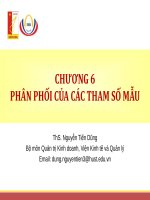Lectures Marketing management: Chapter 17 - ThS. Nguyễn Tiến Dũng
Bạn đang xem bản rút gọn của tài liệu. Xem và tải ngay bản đầy đủ của tài liệu tại đây (1.17 MB, 36 trang )
CHAPTER 17
DESIGNING AND MANAGING INTEGRATED
MARKETING COMMUNICATIONS
Nguyen Tien Dung, MBA
Email:
Chapter Questions
1. What is the role of marketing
2.
3.
4.
5.
communications?
How do marketing communications work?
What are the major steps in developing
effective communications?
What is the communications mix, and how
should it be set?
What is an integrated marketing
communications program?
© Nguyễn Tiến Dũng
2
Main Contents
1. The Role of Marketing Communications
2. Developing Effective Communications
3. Deciding on the Marketing Communications
Mix
4. Managing the Integrated Marketing
Communications Process
© Nguyễn Tiến Dũng
3
1. The Role of Marketing Communications
● The Changing Marketing Communications
Environment
● Marketing Communications, Brand Equity
and Sales
● The Communications Process Models
© Nguyễn Tiến Dũng
4
The Changing Marketing Communication Environment
● Reduced effectiveness of the mass media
● Three (ABC, CBS, NBC) to a hundred
● Fragmentation of audiences with various
communications technologies and Internet
● Mobile broadband: 3G, 4G
● High-speed Internet connection
● DVRs allow consumers to eliminate
commercials with the push of fast-forward
button
© Nguyễn Tiến Dũng
5
Marketing Communications, Brand Equity and Sales
© Nguyễn Tiến Dũng
6
© Nguyễn Tiến Dũng
7
Macro Model of the Communication Process
© Nguyễn Tiến Dũng
8
Micro-models of Consumer Responses: Response
Hierarchy Models
© Nguyễn Tiến Dũng
9
2. Developing Effective Communications
© Nguyễn Tiến Dũng
10
Step 1: Identify Target Audiences
● Usually target customers
● Sometimes broader
● Current Image analysis
● What do they know about
us? (Brand Awareness)
● How do they feel about us?
(Brand Preferences)
© Nguyễn Tiến Dũng
11
Step 2: Determining Objectives
● Perception/Communication Objectives
● % exposed:
● % know
● % like
● % willing to try
● Sales Objectives
● % sales increases
© Nguyễn Tiến Dũng
12
Determine the communications objectives: Examples
● Brand awareness: 80% know
● Brand attitude: 60% like
● Brand purchase intention: 30% intend to buy
the next time
© Nguyễn Tiến Dũng
13
Step 3: Designing the communications
● Message content: what to say?
● Message form: how to say?
● Creative strategy
● Informational appeals: product-related benefits
● Transformational appeals: non-product-related benefits
● Message source: who will present the
message?
● Celebrities
● Ordinary people
● Global adaptation: product, market segment,
style, local or global
© Nguyễn Tiến Dũng
14
Mini-Case: Celebrity Endorsement as a Strategy, p. 486
1. What are the good points
and risky points when
using celebrities to
endorse a company
product?
2. What do you think about
the title of the case? What
does it mean by “as a
strategy”? What are
strategic aspects of using
celebrities?
© Nguyễn Tiến Dũng
15
What are the good points and risky points when using
celebrities to endorse a company product?
● Draw customer attention
● His or her (positive) image brand image
● Help designing products, positioning …
● Brand effect:
● Better known, more awareness
● better, more positive image
● Sales effect : higher sales volume and
value?
© Nguyễn Tiến Dũng
16
Risks when using celebrities?
● High and higher costs
● Bad / negative issues with celebrities
negative brand image
● Fit image to your brands
● Singers (Lam Truong) detergents
© Nguyễn Tiến Dũng
17
● Strategic aspects:
● Use or do not use?
● Use one or several
● Create own celebrities or use outside sources
© Nguyễn Tiến Dũng
18
Step 4: Selecting communications channels
● Personal communications channels
● Non-personal communications channels
● Integration of communications channels
● Criteria:
● Appropriateness with the target audience
● Communication effect
● Cost per thousand (CPM)
● Leaflet: VND400/person CPM1 = 400,000
● Newspaper: Tuoi Tre VND5,000,000/500,000 = CPM2 = 10,000
● TV: VTV3 VND50,000,000/25,000,000 persons = 2 CPM3 = 2,000
© Nguyễn Tiến Dũng
19
Mini-case: John Deere, p. 487
© Nguyễn Tiến Dũng
20
Step 5: Budgets
● Affordable method:
● maximum amount you can pay
● Percentage-of-sales method
● Current revenue: VND 200 billion
● Ratio: 10%.
● Budget: VND 20 billion
● Competitive-parity method
● Pay similarly to the main competitors
● Unilever vs. P&G, Omo, Viso vs. Ariel, Tide
● Objective-and-task method
© Nguyễn Tiến Dũng
21
Objective and task method
1.
2.
3.
4.
5.
6.
Establish the market share goal
Determine the percentage of the market that should be
reached by advertising (E = Exposure)
Determine the percentage of aware prospects that should
be persuaded to try the brand
Determine the number of advertising impressions per 1%
trial rate (F = Frequency)
Determine the number of gross rating points (GRP) that
would have to be purchased: GRP = E x F
Determine the necessary advertising budget on the basis
of the average cost of buying a gross rating point
© Nguyễn Tiến Dũng
22
3. Deciding on the Marketing Communications Mix
● Characteristics of the Marketing
● Communications Mix
● Factors in Setting the Marketing
Communications Mix
● Measuring Communication Results
© Nguyễn Tiến Dũng
23
Factors in setting the marketing communications mix
● Types of product market
● Consumer markets
● Business markets
● Product-life cycle stage
● Introduction: ads, PRs, events and experiences >
personal selling, sales promotion, direct marketing.
● Growth
● Maturity stage: ads, events and experiences,
personal selling are more important
● Decline: sales promotion
● Buyer-readiness stage
© Nguyễn Tiến Dũng
24
Advertising:
● Pervasiveness
● Amplified
expressiveness
● Impersonality: not
obliged to pay
attention or
respond to an ad.
© Nguyễn Tiến Dũng
25









